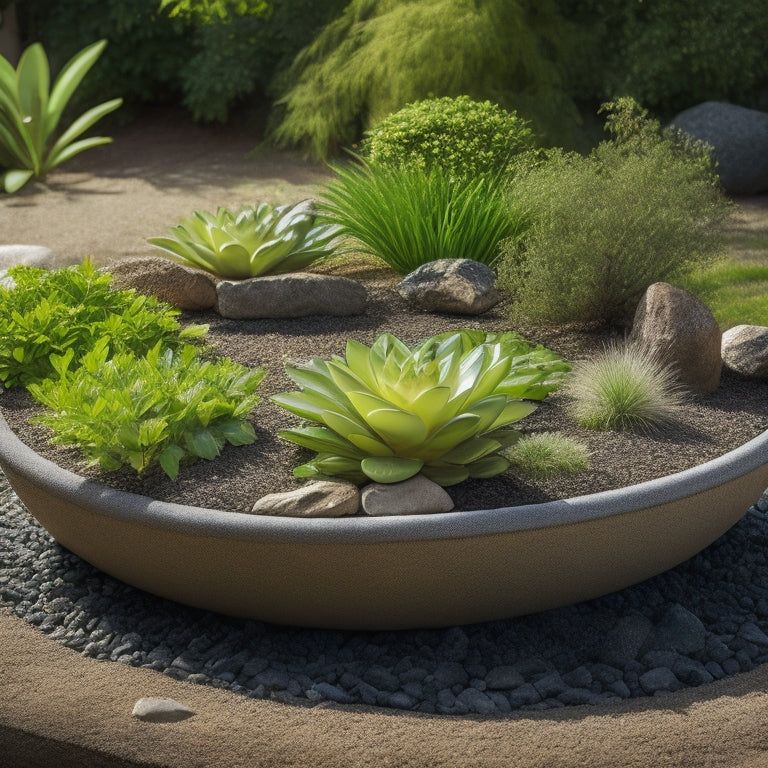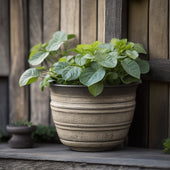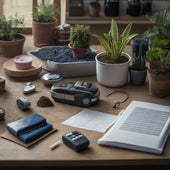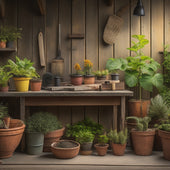
5 Essential Drainage Tips for Large Planters
Share
When it comes to large planters, proper drainage is key to preventing waterlogged soil and root rot. You'll want to choose the right drainage material, like perlite or peat moss mix, and add a layer of gravel to aid in water flow. Create a drainage pathway with perforated pipes or holes, and consider incorporating a water reservoir to regulate moisture. Elevating the planter bottom will also guarantee excess water drains freely. By following these essential drainage tips, you'll be well on your way to creating a healthy environment for your plants to thrive, and there's more to explore to take your planter game to the next level.
Key Takeaways
• Opt for well-draining materials like perlite, vermiculite, or peat moss mix to allow efficient water flow and prevent soil erosion.
• Add a 2-3 inch layer of gravel to prevent clogged drainage holes and improve aeration for healthy root growth.
• Create a drainage pathway using perforated pipes or holes to ensure excess water escapes quickly and reduces waterlogging risk.
• Incorporate a water reservoir to regulate moisture availability, reduce watering frequency, and provide a consistent water supply to plants.
• Elevate the planter bottom using planter feet or blocks to allow excess water to drain freely and prevent waterlogged conditions.
Choose the Right Drainage Material
When selecting a drainage material for your large planter, you'll want to opt for a medium that allows for efficient water flow while preventing soil erosion and clogging.
A well-draining material will prevent waterlogged soil, which can lead to root rot and other problems. Look for materials with high permeability, such as perlite, vermiculite, or a mix of peat moss and perlite. These materials will allow excess water to drain through the planter while retaining enough moisture for healthy plant growth.
Additionally, consider materials that can be easily cleaned or replaced, such as coconut coir or sphagnum moss. When using these materials, make certain to create sufficient drainage holes in the bottom of your planter to allow water to escape.
Aim for at least 1-2 inches of drainage material at the bottom of the planter to guarantee proper moisture retention. By choosing the right drainage material, you'll be able to create a healthy environment for your plants to thrive.
Add a Layer of Gravel
Adding a layer of gravel at the bottom of your large planter provides an extra barrier against clogged drainage holes and guarantees that excess water can flow freely. This vital step secures that your planter's drainage system functions efficiently, preventing waterlogged soil and root rot.
When selecting a gravel type, consider the drainage depth you're aiming for. A general rule of thumb is to use a 2-3 inch layer of gravel with a diameter of 1/4 inch to 1/2 inch. This allows for adequate water flow while preventing the gravel from slipping through the drainage holes.
Here are three key benefits of adding a gravel layer:
-
Improved drainage: Gravel allows water to flow quickly through the planter, reducing the risk of waterlogging.
-
Reduced clogging: Gravel prevents debris and soil from entering the drainage holes, securing they remain clear.
-
Enhanced aeration: Gravel allows air to circulate around the roots, promoting healthy root growth and development.
Create a Drainage Pathway
To guarantee efficient water flow, create a drainage pathway by placing a perforated pipe or a series of holes in the bottom of your large planter, allowing excess water to escape freely. This is vital, as it prevents waterlogged soil and root rot.
When designing your drainage pathway, consider the soil composition you'll be using. For example, if you're using a dense, clay-based soil, you may need more drainage holes to make certain excess water can escape quickly.
You can create drainage holes using a drill or a sharp object, spacing them evenly apart to make certain consistent water flow. Aim for holes that are about 1-2 inches in diameter, depending on the size of your planter.
For larger planters, you may need to use a combination of drainage holes and a perforated pipe to make certain efficient water flow. Remember to position the drainage pathway at the lowest point of your planter, allowing gravity to do its job and direct excess water out of the planter.
Incorporate a Water Reservoir
You can take your planter's drainage system to the next level by incorporating a water reservoir, which will help regulate water availability and reduce the need for frequent watering.
By doing so, you'll create a more efficient system that optimizes water retention and reduces waste. A water reservoir is a hidden compartment within the planter that stores excess water, allowing the soil to draw from it as needed. This design feature offers several benefits, including:
-
Reduced watering frequency: With a water reservoir, you'll water your plants less often, as the soil will have a steady supply of moisture.
-
Improved water retention: The reservoir helps to retain water in the soil, reducing runoff and preventing waterlogged soil.
-
Increased plant health: By providing a consistent water supply, your plants will thrive, and you'll notice improved growth and reduced stress.
Elevate the Planter Bottom
By elevating the planter bottom, you guarantee that excess water can freely drain away from the soil, preventing waterlogged conditions that can be detrimental to plant health. This is especially essential for large planters, which can hold a significant amount of water.
To achieve this, you can use planter feet or blocks to raise the planter off the ground. This creates a gap between the planter and the surface, allowing water to flow out of the drainage holes and away from the soil.
When selecting planter feet, choose ones that are specifically designed for large planters and can support the weight of the planter, soil, and plants. Confirm the feet are spaced evenly to maintain stability and prevent the planter from tipping over.
Additionally, consider using a planter with built-in drainage holes or drill your own holes in the bottom of the planter to facilitate water flow.
Frequently Asked Questions
Can I Use a Single Drainage Hole in a Large Planter?
When it comes to drainage, you're wondering if a single hole will suffice in a large planter. Unfortunately, it's not recommended.
A single drainage hole can lead to waterlogging, especially in larger planters. As the planter size increases, so does the water volume, making it harder for a single hole to efficiently drain excess water.
You'll want to contemplate multiple drainage holes or a more advanced drainage system to guarantee healthy root growth and prevent waterlogged soil.
How Often Should I Clean the Drainage Material in My Planter?
Did you know that clogged drainage systems can reduce plant growth by up to 30%?
To avoid this, you'll need to clean the drainage material in your planter regularly. For ideal planter health, perform drainage maintenance every 2-3 months, or when you notice water pooling on the surface.
Remove any debris, and gently rinse the material with water to guarantee it continues to function efficiently.
Will Adding Drainage Affect the Aesthetic of My Planter?
When you add drainage to your planter, you'll inevitably impact its aesthetics. The good news is that you can minimize the visual effect.
Opt for drainage materials that blend with your planter design, such as small rocks or decorative pebbles. You can also choose a planter with built-in drainage, which will maintain its original look.
Ultimately, it's about striking a balance between functionality and aesthetics. By doing so, you'll create a beautiful and healthy environment for your plants to thrive.
Can I Use a Planter Without Drainage in a Shaded Area?
You're wondering if you can get away with using a planter without drainage in a shaded area. While shade reduces evaporation, it's still essential to take into account moisture retention.
Without proper drainage, waterlogged soil can lead to root rot. Instead, explore drainage alternatives like adding organic matter or perlite to improve soil structure and water absorption.
This way, you can create a balanced environment for your plants to thrive.
Do Self-Watering Planters Eliminate the Need for Drainage?
When considering self-watering planters, you might wonder if they eliminate the need for drainage.
While these planters do offer benefits, such as reduced watering frequency, they don't entirely eliminate the need for drainage.
Self-watering planters rely on moisture retention, where excess water is stored in a reservoir for later use.
However, this system can still lead to waterlogged soil if not properly maintained, highlighting the importance of adequate drainage to prevent root rot and other issues.
Conclusion
By following these 5 essential drainage tips, you'll be well on your way to creating a thriving oasis in your large planter.
Remember, 'an ounce of prevention is worth a pound of cure' - a little extra effort upfront will save you from a world of waterlogged woes down the line.
With proper drainage, your plants will flourish, and you'll avoid the frustration of dealing with root rot and other moisture-related issues.
Happy planting!
Related Posts
-

What Makes a Beautiful Border Planter Design
When crafting a beautiful border planter design, you balance fundamental elements like durable cinder block structure...
-

What Makes a Beautiful Border Planter Design
When crafting a beautiful border planter design, you balance fundamental elements like durable cinder block structure...
-

What Makes a Beautiful Border Planter Design
When crafting a beautiful border planter design, you balance fundamental elements like durable cinder block structure...
-

What Makes a Beautiful Border Planter Design
When crafting a beautiful border planter design, you balance fundamental elements like durable cinder block structure...
-

What Makes a Beautiful Border Planter Design
When crafting a beautiful border planter design, you balance fundamental elements like durable cinder block structure...
-

What Makes a Beautiful Border Planter Design
When crafting a beautiful border planter design, you balance fundamental elements like durable cinder block structure...
-

What Makes a Beautiful Border Planter Design
When crafting a beautiful border planter design, you balance fundamental elements like durable cinder block structure...
-

What Makes a Beautiful Border Planter Design
When crafting a beautiful border planter design, you balance fundamental elements like durable cinder block structure...
-

What Makes a Beautiful Border Planter Design
When crafting a beautiful border planter design, you balance fundamental elements like durable cinder block structure...
-

What Makes a Beautiful Border Planter Design
When crafting a beautiful border planter design, you balance fundamental elements like durable cinder block structure...
-

What Makes a Beautiful Border Planter Design
When crafting a beautiful border planter design, you balance fundamental elements like durable cinder block structure...
-

What Makes a Beautiful Border Planter Design
When crafting a beautiful border planter design, you balance fundamental elements like durable cinder block structure...
-

What Makes a Beautiful Border Planter Design
When crafting a beautiful border planter design, you balance fundamental elements like durable cinder block structure...
-

What Makes a Beautiful Border Planter Design
When crafting a beautiful border planter design, you balance fundamental elements like durable cinder block structure...
-

What Makes a Beautiful Border Planter Design
When crafting a beautiful border planter design, you balance fundamental elements like durable cinder block structure...
-

What Makes a Beautiful Border Planter Design
When crafting a beautiful border planter design, you balance fundamental elements like durable cinder block structure...
-

What Makes a Beautiful Border Planter Design
When crafting a beautiful border planter design, you balance fundamental elements like durable cinder block structure...
-

What Makes a Beautiful Border Planter Design
When crafting a beautiful border planter design, you balance fundamental elements like durable cinder block structure...
-

What Makes a Beautiful Border Planter Design
When crafting a beautiful border planter design, you balance fundamental elements like durable cinder block structure...
-

What Makes a Beautiful Border Planter Design
When crafting a beautiful border planter design, you balance fundamental elements like durable cinder block structure...
-

What Makes a Beautiful Border Planter Design
When crafting a beautiful border planter design, you balance fundamental elements like durable cinder block structure...
-

What Makes a Beautiful Border Planter Design
When crafting a beautiful border planter design, you balance fundamental elements like durable cinder block structure...
-

What Makes a Beautiful Border Planter Design
When crafting a beautiful border planter design, you balance fundamental elements like durable cinder block structure...
-

What Makes a Beautiful Border Planter Design
When crafting a beautiful border planter design, you balance fundamental elements like durable cinder block structure...
-

What Makes a Beautiful Border Planter Design
When crafting a beautiful border planter design, you balance fundamental elements like durable cinder block structure...
-

What Makes a Beautiful Border Planter Design
When crafting a beautiful border planter design, you balance fundamental elements like durable cinder block structure...
-

What Makes a Beautiful Border Planter Design
When crafting a beautiful border planter design, you balance fundamental elements like durable cinder block structure...
-

What Makes a Beautiful Border Planter Design
When crafting a beautiful border planter design, you balance fundamental elements like durable cinder block structure...
-

What Makes a Beautiful Border Planter Design
When crafting a beautiful border planter design, you balance fundamental elements like durable cinder block structure...
-

What Makes a Beautiful Border Planter Design
When crafting a beautiful border planter design, you balance fundamental elements like durable cinder block structure...
-

What Makes a Beautiful Border Planter Design
When crafting a beautiful border planter design, you balance fundamental elements like durable cinder block structure...
-

Accurate Measuring for DIY Block Planters Made Easy
As you begin building a DIY block planter, precise measurement is essential for a sturdy structure that can support s...
-

Accurate Measuring for DIY Block Planters Made Easy
As you begin building a DIY block planter, precise measurement is essential for a sturdy structure that can support s...
-

Accurate Measuring for DIY Block Planters Made Easy
As you begin building a DIY block planter, precise measurement is essential for a sturdy structure that can support s...
-

Accurate Measuring for DIY Block Planters Made Easy
As you begin building a DIY block planter, precise measurement is essential for a sturdy structure that can support s...
-

Accurate Measuring for DIY Block Planters Made Easy
As you begin building a DIY block planter, precise measurement is essential for a sturdy structure that can support s...
-

Accurate Measuring for DIY Block Planters Made Easy
As you begin building a DIY block planter, precise measurement is essential for a sturdy structure that can support s...
-

Accurate Measuring for DIY Block Planters Made Easy
As you begin building a DIY block planter, precise measurement is essential for a sturdy structure that can support s...
-

Accurate Measuring for DIY Block Planters Made Easy
As you begin building a DIY block planter, precise measurement is essential for a sturdy structure that can support s...
-

Accurate Measuring for DIY Block Planters Made Easy
As you begin building a DIY block planter, precise measurement is essential for a sturdy structure that can support s...
-

Accurate Measuring for DIY Block Planters Made Easy
As you begin building a DIY block planter, precise measurement is essential for a sturdy structure that can support s...
-

Accurate Measuring for DIY Block Planters Made Easy
As you begin building a DIY block planter, precise measurement is essential for a sturdy structure that can support s...
-

Accurate Measuring for DIY Block Planters Made Easy
As you begin building a DIY block planter, precise measurement is essential for a sturdy structure that can support s...
-

Accurate Measuring for DIY Block Planters Made Easy
As you begin building a DIY block planter, precise measurement is essential for a sturdy structure that can support s...
-

Accurate Measuring for DIY Block Planters Made Easy
As you begin building a DIY block planter, precise measurement is essential for a sturdy structure that can support s...
-

Accurate Measuring for DIY Block Planters Made Easy
As you begin building a DIY block planter, precise measurement is essential for a sturdy structure that can support s...
-

Accurate Measuring for DIY Block Planters Made Easy
As you begin building a DIY block planter, precise measurement is essential for a sturdy structure that can support s...
-

Accurate Measuring for DIY Block Planters Made Easy
As you begin building a DIY block planter, precise measurement is essential for a sturdy structure that can support s...
-

Accurate Measuring for DIY Block Planters Made Easy
As you begin building a DIY block planter, precise measurement is essential for a sturdy structure that can support s...
-

Accurate Measuring for DIY Block Planters Made Easy
As you begin building a DIY block planter, precise measurement is essential for a sturdy structure that can support s...
-

Accurate Measuring for DIY Block Planters Made Easy
As you begin building a DIY block planter, precise measurement is essential for a sturdy structure that can support s...
-

Accurate Measuring for DIY Block Planters Made Easy
As you begin building a DIY block planter, precise measurement is essential for a sturdy structure that can support s...
-

Accurate Measuring for DIY Block Planters Made Easy
As you begin building a DIY block planter, precise measurement is essential for a sturdy structure that can support s...
-

Accurate Measuring for DIY Block Planters Made Easy
As you begin building a DIY block planter, precise measurement is essential for a sturdy structure that can support s...
-

Accurate Measuring for DIY Block Planters Made Easy
As you begin building a DIY block planter, precise measurement is essential for a sturdy structure that can support s...
-

Accurate Measuring for DIY Block Planters Made Easy
As you begin building a DIY block planter, precise measurement is essential for a sturdy structure that can support s...
-

Accurate Measuring for DIY Block Planters Made Easy
As you begin building a DIY block planter, precise measurement is essential for a sturdy structure that can support s...
-

Accurate Measuring for DIY Block Planters Made Easy
As you begin building a DIY block planter, precise measurement is essential for a sturdy structure that can support s...
-

What Materials Do You Need for a DIY Planter
You'll need a combination of structural components, soil and compost, drainage materials, and decorative elements to ...
-

What Materials Do You Need for a DIY Planter
You'll need a combination of structural components, soil and compost, drainage materials, and decorative elements to ...
-

What Materials Do You Need for a DIY Planter
You'll need a combination of structural components, soil and compost, drainage materials, and decorative elements to ...
-

What Materials Do You Need for a DIY Planter
You'll need a combination of structural components, soil and compost, drainage materials, and decorative elements to ...
-

What Materials Do You Need for a DIY Planter
You'll need a combination of structural components, soil and compost, drainage materials, and decorative elements to ...
-

What Materials Do You Need for a DIY Planter
You'll need a combination of structural components, soil and compost, drainage materials, and decorative elements to ...
-

What Materials Do You Need for a DIY Planter
You'll need a combination of structural components, soil and compost, drainage materials, and decorative elements to ...
-

What Materials Do You Need for a DIY Planter
You'll need a combination of structural components, soil and compost, drainage materials, and decorative elements to ...
-

What Materials Do You Need for a DIY Planter
You'll need a combination of structural components, soil and compost, drainage materials, and decorative elements to ...
-

What Materials Do You Need for a DIY Planter
You'll need a combination of structural components, soil and compost, drainage materials, and decorative elements to ...
-

What Materials Do You Need for a DIY Planter
You'll need a combination of structural components, soil and compost, drainage materials, and decorative elements to ...
-

What Materials Do You Need for a DIY Planter
You'll need a combination of structural components, soil and compost, drainage materials, and decorative elements to ...
-

What Materials Do You Need for a DIY Planter
You'll need a combination of structural components, soil and compost, drainage materials, and decorative elements to ...
-

What Materials Do You Need for a DIY Planter
You'll need a combination of structural components, soil and compost, drainage materials, and decorative elements to ...
-

What Materials Do You Need for a DIY Planter
You'll need a combination of structural components, soil and compost, drainage materials, and decorative elements to ...
-

What Materials Do You Need for a DIY Planter
You'll need a combination of structural components, soil and compost, drainage materials, and decorative elements to ...
-

What Materials Do You Need for a DIY Planter
You'll need a combination of structural components, soil and compost, drainage materials, and decorative elements to ...
-

What Materials Do You Need for a DIY Planter
You'll need a combination of structural components, soil and compost, drainage materials, and decorative elements to ...
-

What Materials Do You Need for a DIY Planter
You'll need a combination of structural components, soil and compost, drainage materials, and decorative elements to ...
-

What Materials Do You Need for a DIY Planter
You'll need a combination of structural components, soil and compost, drainage materials, and decorative elements to ...
-

What Materials Do You Need for a DIY Planter
You'll need a combination of structural components, soil and compost, drainage materials, and decorative elements to ...
-

What Materials Do You Need for a DIY Planter
You'll need a combination of structural components, soil and compost, drainage materials, and decorative elements to ...
-

What Materials Do You Need for a DIY Planter
You'll need a combination of structural components, soil and compost, drainage materials, and decorative elements to ...
-

What Materials Do You Need for a DIY Planter
You'll need a combination of structural components, soil and compost, drainage materials, and decorative elements to ...
-

What Materials Do You Need for a DIY Planter
You'll need a combination of structural components, soil and compost, drainage materials, and decorative elements to ...
-

What Materials Do You Need for a DIY Planter
You'll need a combination of structural components, soil and compost, drainage materials, and decorative elements to ...
-

What Materials Do You Need for a DIY Planter
You'll need a combination of structural components, soil and compost, drainage materials, and decorative elements to ...
-

What Materials Do You Need for a DIY Planter
You'll need a combination of structural components, soil and compost, drainage materials, and decorative elements to ...
-

What Materials Do You Need for a DIY Planter
You'll need a combination of structural components, soil and compost, drainage materials, and decorative elements to ...
-

What Materials Do You Need for a DIY Planter
You'll need a combination of structural components, soil and compost, drainage materials, and decorative elements to ...


